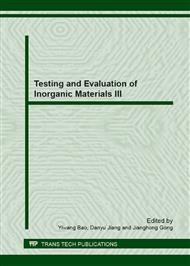[1]
Tinschert J, Natt G, Mautsch W, Augthun M Spiekermann H., Fracture resistance of lithium disilicate-, Alumina- and zirconia-based three-unit fixed partial dentures: a laboratory study, Int J Prosthodont. 14(2001)231-8.
Google Scholar
[2]
Guazzato M, Proos K, Quach L, Swain MV. Strength reliability and mode of fracture of bilayered porcelain/zirconia(YSZ) dental ceramics, Biomaterials 25(2004)5045-52.
DOI: 10.1016/j.biomaterials.2004.02.036
Google Scholar
[3]
Kelly JR, Denry I. Stablized zirconia as a structureal ceramic: an overview. Dent Mater 24(2008)289-98.
Google Scholar
[4]
Christel P, Meunier A, Heller M, Torre JP, Peille CN. Mechanical properties and short-term in vivo evaluation of yttium-oxide-partially-stabilized zirconia, J Biomed Mater Res 23(1989)45-61.
DOI: 10.1002/jbm.820230105
Google Scholar
[5]
Swab JJ. Low temperature degradation of YSZ materials, J Mater Sci 26(1991)6706-14.
Google Scholar
[6]
Shimizu K, Oka M, Kumur P, Kotoura Y, Yamamuro T, Makinouchi K, Nakamura T. Time-denpendent changes in the mechanical properties of zirconia ceramic. J Biomed Mater Res 27(1993)729-34.
DOI: 10.1002/jbm.820270605
Google Scholar
[7]
Cales B, STefani Y, Lilley E. Long-term in vivo and in vitro aging of a zirconia ceramic used in orthopaedy. J Biomed Mater Res 28(1994)619-24.
DOI: 10.1002/jbm.820280512
Google Scholar
[8]
Sato Y, Shimada M. Transformation of yttria-doped trtragonal ZrO2 polycrystals by annealing in water. J Am Ceram Soc 68(1985)356-9.
DOI: 10.1111/j.1151-2916.1985.tb15239.x
Google Scholar
[9]
Sato Y, Besshi T, Tada Y Effects of surface-finishing condition and annealing on transformation sensitivity of a 3 mol. % Y2O3 stabilized tetragonal zirconia surface under interaction of lubricant, Wear 194(1996)204-211.
DOI: 10.1016/0043-1648(95)06867-8
Google Scholar
[10]
I.M. Ross, W.M. Rainforth, D.W. McComb, A.J. Scott, and R. Brydson The role of trace additions of alumina to yttria-tetragonal Zirconia polycrystals(YSZ), Scripta Materialia 45(2001)653-660.
DOI: 10.1016/s1359-6462(01)01076-4
Google Scholar
[11]
Verkerk MJ, Winnubst AJA, Burgraaf AJ. Effect of Impurities on Sintering and Conductivity of Yttria-Stabilized Zirconia, J Mat Sci 17(1982)3113.
DOI: 10.1007/bf01203473
Google Scholar
[12]
Suzuki TS, Sakka Y, Morita K, Hiraga K Enhanced superplasticity in a alumina-containing zirconia prepared by colloidal processing , Scripta Mater 43(2000)705.
DOI: 10.1016/s1359-6462(00)00469-3
Google Scholar
[13]
Heuer A.H., Ruhle M. Phase transformations in ZrO2 containing ceramics: The instability of c-ZrO2 and the resulting diffusion controlled reactions Adv. Ceram. 12(1984)1-13.
Google Scholar
[14]
Schneider J., Begand S., Kriegel R., Kaps C., Glien W., and Oberbach T. T Low-Temperature Aging Behavior of Alumina-Toughened Zirconia, J. Am. Ceram. Soc 91(2008)3613-8.
DOI: 10.1111/j.1551-2916.2008.02700.x
Google Scholar


